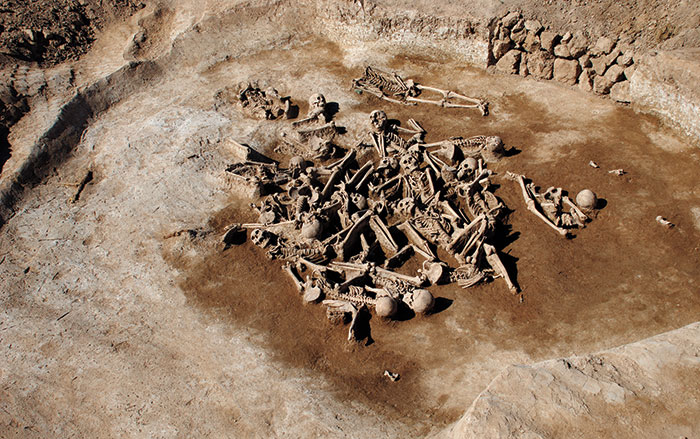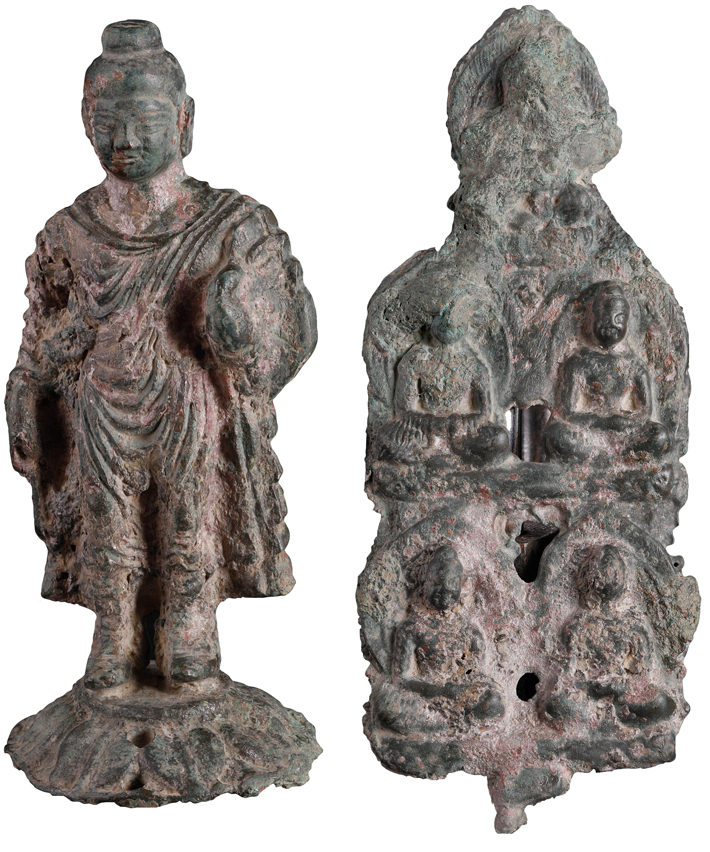Preserved by centuries of flood-borne silt, a rural landscape offers a new look at the Han Dynasty

(Courtesy Liu Maiwang, Henan Provincial Institute of Cultural Relics and Archaeology)
T. R. Kidder often says that a river is like a text. It leaves behind telltale layers of silt, carves channels when it runs quickly, and makes patterns in the sand when the water is low. If that is the case, he says, then China's Yellow River is one hell of a read. Kidder, a geoarchaeologist at Washington University in St. Louis, is standing in a place where the river once flowed, at the bottom of a hole dug 30 feet into the layers of sediment it left over millennia. The bands of colored mud provide a timeline—Kidder's feet are somewhere near the end of the Pleistocene, around 10,500 years ago, while his head is a few feet below the Han Dynasty, 206 B.C.-A.D. 220.
In the cross-section of sediment, Kidder sees the undulating furrows of an agricultural field and, in the layer of red clay above it, the fate of a 2,000-year-old farming community. In this stretch of peanut fields and peach trees in the northern part of China's Henan Province, near the village of Sanyangzhuang, archaeologists have discovered an entire landscape sealed away by the whims of the Yellow River. Kidder is at the site of a remarkably well-preserved rural homestead. Footprints are still visible in the fields, and within the collapsed walls of a courtyard, intact millstones and ceramic food steamers look like they are waiting to be used. Two thousand years ago the Yellow River took this place by surprise and preserved a never-before-seen picture of farming life in the Han Dynasty, far from any imperial city, across an area so large it will keep archaeologists busy for generations.
The river had broken its banks a few miles away and Kidder imagines—invoking Carl Sandburg—that the water came in "on little cat feet," in a slow trickle at first and then faster. The Han settlement was in a low spot, a dangerous place to be considering the Yellow River's well-earned reputation for caprice. The water rose and rose until the entire area was flooded. Its residents traveled roughly 40 miles to reach higher ground, leaving behind tile-roofed houses and well-maintained fields. They abandoned coins and farming tools and looms still in use, and traveled along roads that still bear the tracks of their wooden wheels. The Yellow River covered it all in thick, heavy silt. Today, though the river has meandered north, the county is still called Nei Huang, or "Inside Yellow"—a reminder of how much time it spent under water.
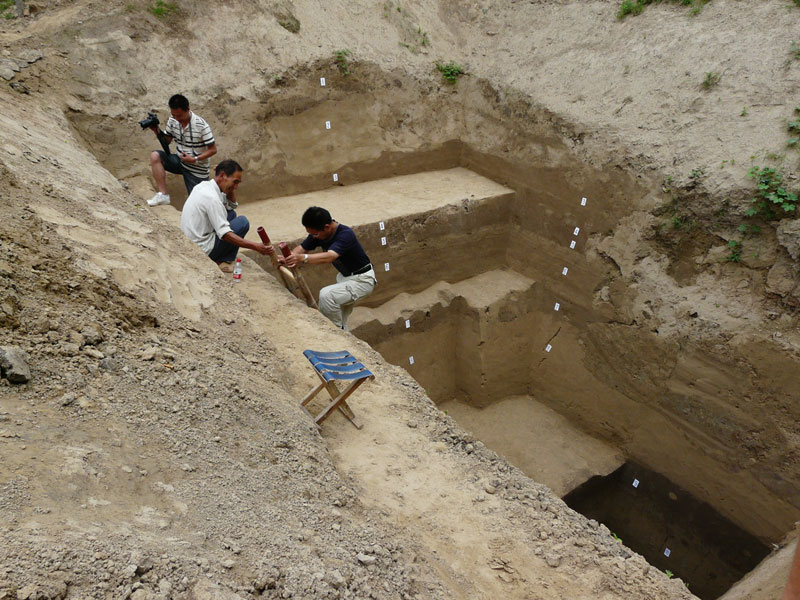
(Courtesy Liu Maiwang, Henan Provincial Institute of Cultural Relics and Archaeology)
Archaeologists have now excavated four homestead sites here, which they refer to as compounds. Each compound consists of a house, made of a series of covered rooms and courtyards surrounded by a rammed-earth wall, and the area immediately around it. One compound was surrounded by a moat, another by trees. Each of the four is within 500 yards of the next, and tests indicate there are at least 12 more sites within a few square miles. A bit further afield, the top of a Han Dynasty wall is visible, hinting that an entire city might lie in wait. Kidder jokes that if this find had been made in America, where manpower is more limited, overwhelmed archaeologists might have covered it back up and run.
After three years of visiting the site each summer, the American archaeologist still seems amused by his good fortune. Kidder, a self-proclaimed "river guy" or "dirt guy," has spent most of his life studying the Mississippi River. He is most at home with mud in his hands, examining it through glasses that cling precariously to the tip of his nose. His Chinese host, Liu Haiwang, is a senior researcher at the Henan Provincial Institute of Cultural Relics and Archaeology and the head archaeologist at the site. He is thin and polite and extremely organized. While Kidder examined silt, Liu measured the scope of their archaeological task by putting together a meticulous 10-foot-square diorama of the area, with little blue lights flickering around every possible new site. "The area is huge," he says. It also presents a conservation challenge—the state of preservation is so excellent that the archaeologists are hesitant to disturb the first layer of collapsed roof tiles and risk exposing what is underneath to Henan's up-and-down climate. "We have to be careful; we have to go slowly," says Liu.
If Kidder is a reader of rivers, Liu is fluent in ceramic tiles. He first came to Sanyangzhuang in 2003 on a familiar errand. A construction team digging an irrigation ditch hit what appeared to be a wall and a pile of roof tiles. So they changed direction. A few yards further they hit more tiles—a collapsed roof. Two archaeological finds in one ditch were enough cause to notify the local authorities, and Liu's institute sent him to investigate. He examined the find, read the patterns on the roof tiles, and dated the remains to the first half of the Han Dynasty. The construction crew changed direction again and Liu left for another project in the city of Chongqing. Two years later he returned to follow up on the earlier discovery. "It wasn't until 2005 that we realized how significant the find was," Liu says. "We found the fields."
The Han Dynasty fields at the site are preserved so perfectly that once they are exposed it looks as if they'd been plowed last week. The furrows begin just beyond the walls of each compound and Liu, citing historical records of farming practices, estimates they extend for around four square miles. The fields confirm an important feature of the site—it is no monument, tomb, or tiny outpost, but an active farming settlement, a picture of everyday rural life from around 100 B.C. to A.D. 40.

(Courtesy Liu Maiwang, Henan Provincial Institute of Cultural Relics and Archaeology)
This is new territory for archaeologists in China, where most work is focused on imperial sites and cities, about which Chinese rulers and historians kept meticulous records. Here, however, Liu has a segment of society that has been left out of the histories and has been unexplored archaeologically. This is China's first look at a farming community far away from the gates of an imperial capital, outside the protective walls of any city. Over five years of excavation, Liu has uncovered a surprisingly interconnected and prosperous settlement.
"There are historical records that tell us what life was like in Chang'an and Luoyang," he says, referencing the capitals of the Western and Eastern Han Dynasties, respectively. "But in China's plains, the lifestyle was different—we've never researched it before because we've never had the material."
In most parts of rural China, when peasants left a place like this, they took their pots, plows, and tools with them. But at the site outside Sanyangzhuang, life was in motion when the water came. Roof tiles are carefully stacked outside of one house, to be used for repairs. Weights used for weaving sit under the base of a loom. The largest of the four sites, Compound Two, has been completely uncovered. The warehouse-sized stretch includes the house itself, a well, the beginning of a field, and a large depression that Liu thinks might have been a seasonal pool. The house features a large entry courtyard and kitchen, living quarters, and a smaller courtyard tucked away in the back.
Piles of cracked roof tiles, which fell when the flood collapsed walls, cover the site today. The curve of a large ceramic pot—perhaps for storing water—peeks out from what was once a covered room. So far, archaeologists have also found coins, bronze and stone tools, and more pottery, even without excavating many of the enclosed rooms. Liu picks up a tile and runs his fingers lightly over shallow, closely spaced ridges and round depressions. "Late Western Han," he says. Another tile has a mesh pattern, as if it were dried on a burlap sack. "This is more typical during Eastern Han," he says. Some of the bricks used for the homestead's walls and flooring have unusual patterns, stripes Liu has never seen before. "Maybe they had a local kiln operating nearby," he says.

(Courtesy Liu Maiwang, Henan Provincial Institute of Cultural Relics and Archaeology)
The tiles point to a unique period in China's history. The four hundred years of the Han Dynasty were unusually peaceful, bracketed by periods when warlords struggled for control—the Spring and Autumn and Warring States periods before, and the Three Kingdoms period after. According to histories, this lasting peace allowed the development of new cultivation techniques, such as crop rotation and improved plows. The flood probably came during a brief interlude in this history of peace and advancement, the 14-year Xin Dynasty that marked the transition from Western to Eastern Han. At that time, Wang Mang, a Han Dynasty official, had seized the throne from the ruling family and spent his few years in power trying to implement a series of land and tax reforms. Kidder guesses that the flood played a role in ending the usurper's rule. Written records mention a break in the Yellow River around A.D. 11 that caused famine and mass migration. The fleeing of the Han settlers, combined with a massive drought, helped catalyze a series of agrarian rebellions and bring about the downfall of Wang Mang. By A.D. 25, a descendant of Western Han royalty had retaken the throne, establishing the Eastern Han Dynasty, which lasted for another 200 years.
The Han settlement that Kidder and Liu are studying was neither the first nor last to end up under water. A pattern—common to floodplains all over the world—repeated over the centuries here: occupation, flood, and abandonment, over and over again. No matter how many times the water came, people kept coming back for the rich, river-enriched soil. While Kidder examines silt near the bottom of the 30-foot hole, Liu stands on a platform halfway back to the surface, where there is another field preserved in silt, as yet undated.
This pattern occurs because the Yellow River is a flowing mudslide. The river normally carries an enormous silt burden, and a flood can increase it dramatically. During a 1958 flood, for example, sediment levels in the river were measured at 35 pounds per cubic foot, and an observer described its surface as "wrinkled." The river was primarily dirt.
The Yellow River flows in a braided stream, a network of smaller channels that weave in and out of each other. "Think of the river coming into Henan like a loose hose," says Kidder. "It's just spraying all over the place." In each channel, silt slowly builds the riverbed above the surrounding landscape and gives the river the devastating habit of breaking its banks and changing course. In some places, where water flowed slowly or not at all, sediment could accumulate and preserve whatever was below. In other places, it might flow fast and furious, carving deep channels. A flooding Yellow River might crush one ancient household and preserve the next.
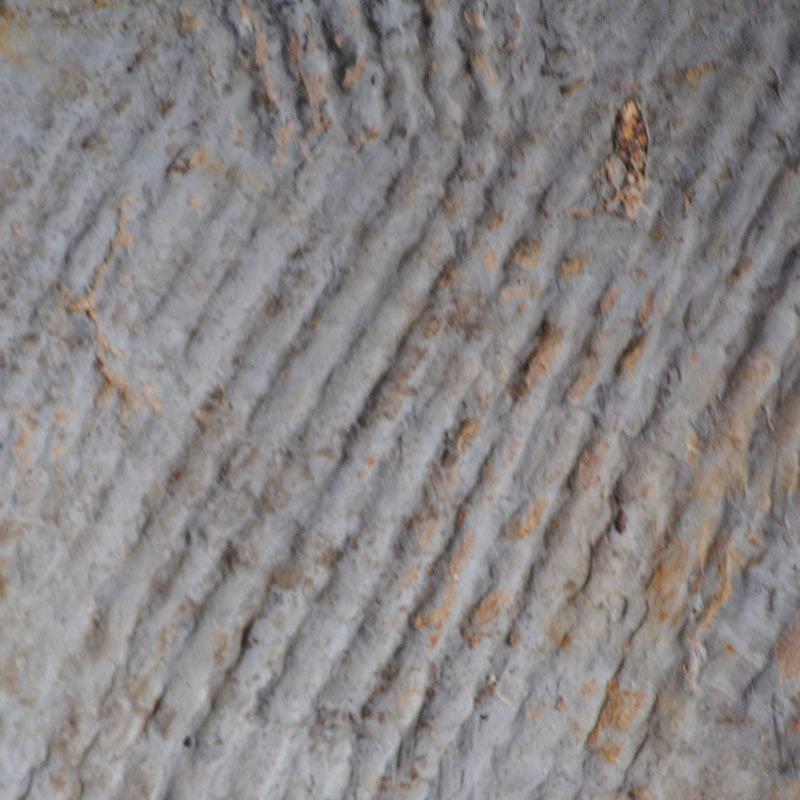
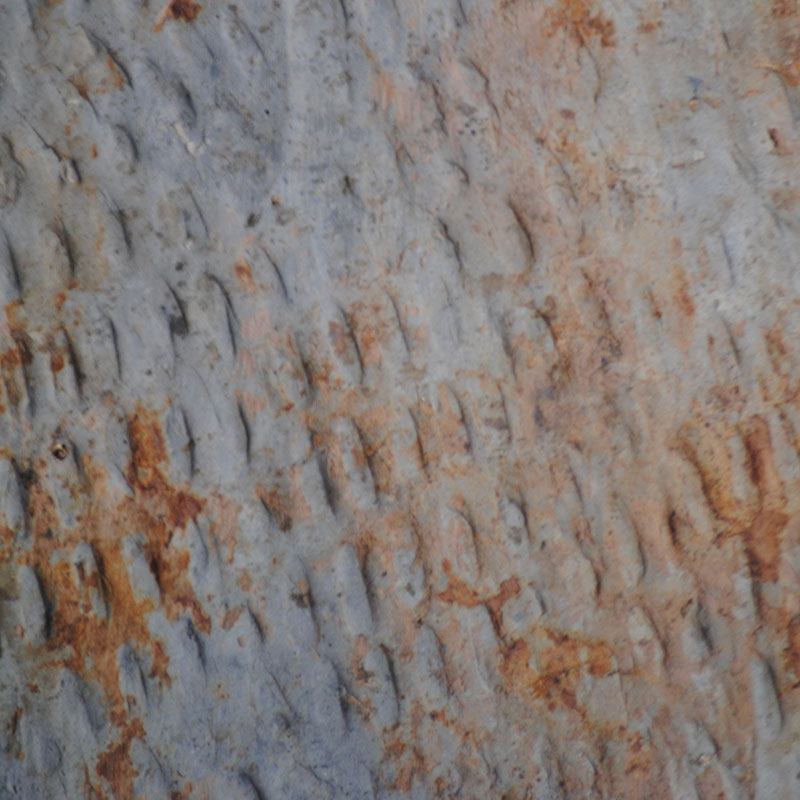


The sediment left behind changes depending on the river's mood. In Kidder's excavation, the cross-section, or profile, of each flood has a different color and texture. Kidder's reading of the Han flood reveals two distinct layers: one rust-colored and syrupy to the touch, the other dark brown and composed of a denser, thicker mud. The flood was part of a centuries-long cycle, but its two phases were uniquely suited to preserving the landscape. A slow initial flood allowed a protective layer of silt to settle to the bottom, and then a second, stronger flood brought more silt that sealed it all away. The first stage would have undermined the foundations of buildings and walls. When the second wave came, roofs collapsed and sank into the layer of mud already covering the ground below. "Then there was a period of time when the river was relatively still," says Kidder, who guesses the area stayed under water for nearly 50 years while the river slowly carved out a new path elsewhere. More floods would come, including a strong one in the Tang Dynasty (A.D. 618-907), but higher up the dirt in Kidder's profile becomes loose and sandy, a sign that the river had settled in elsewhere.
The monumental volume of sediment is key to preserving the landscape so well—a river with less silt would simply erode away whatever lay in its path. And a more austere, less prosperous settlement would have left little behind to suggest its existence. "To get something like this, you need a river system that buries things and a cultural system that practices things on this scale," Kidder says.
The prolonged stability of the Han would have helped the Sanyangzhuang settlement prosper and expand from simple agriculture to trade, silk-making, and a whole range of cultural production including ceramics, textiles, and stone-carving. The land they worked was likely their own and they benefited from it. "These were not peasants," Liu says. "These were people with connections to trade and comfortable lifestyles."
Signs of their prosperity are scattered throughout the site. An indoor toilet at Compound Two is one of the most opulent Liu has seen. "There were bricks covering the floors," he says emphatically. An average family would have been content with packed dirt. Some of the roof tiles are the largest Han Dynasty tiles on record, about the size of a movie poster. Archaeologists also uncovered corner tiles with the Chinese characters for "Yi Shou Wan Sui," or "long life," imprinted on the end—a mark generally reserved for high-ranking families.
A system of roads uncovered nearby suggests that each household was connected to the surrounding community and probably beyond. Liu is particularly excited to show off stumps of mulberry trees and the imprints of their leaves, evidence that one household was involved in silk production. "This could be the real start of the Silk Road," he says. Their silk could have made it to the imperial capital and from there to as far away as Baghdad and Byzantium, with Roman gold coins filtering back in return. Without the security that allowed for the flow of silk and wealth, Liu conjectures, compounds like these could never have been built.
The Sanyangzhuang sites are unusual not only for their apparent prosperity, but also for the rare example they provide of farmers living permanently outside the protection of city walls. "During the Warring States period, farmers would live inside cities and go out during the day to work," Liu explains. "Or they would live in smaller towns and go out to cultivate their fields during certain times of year." That settlement pattern persisted throughout Chinese history and Liu guesses that many farmers still lived like that during the Han. In Sanyangzhuang, however, the farmers appear to have lived exposed on the plain, building large houses a few steps from their fields and a comfortable distance from their neighbors.
Today, with the Yellow River 20 miles in the distance and no roving warlords, the Sanyangzhuang sites are facing a new set of threats. Henan's climate—cold in the winter and wet and hot during the summer—can be hostile to an exposed site. A large warehouse has been constructed over a portion of the site, part of a recently opened tourism complex that includes a small museum. The building is not air-conditioned, however, and in Henan's summer, the exposed parts of the Han Dynasty layer develop a thick green sheen of mold. Liu has experimented with a range of anti-mold agents and thinks he has found the right formula. The other excavated sites have all been re-covered with loose dirt until Liu can get permission to build additional structures and prepare conservation treatments.
The cautious archaeologist also faces dilemmas courtesy of the Yellow River. Unlike Pompeii, where in some places volcanic ash and lava fragments filled houses and preserved their structures, the river collapsed the buildings as it preserved their contents. Typically, Kidder says, excavators would record and chart what they had discovered, and then go deeper. This site is so well-preserved, however, that Liu has stopped at roof level, wanting to keep the outline of the houses and collapsed roofs complete. He hopes to excavate further at some sites but leave others as they were found. This way, he says, archaeologists and visitors can understand both life in the settlement and the way the disaster unfolded.
"There will be some difficult decisions to make," Liu says. There are so many layers of occupation, he points out, that archaeologists could potentially keep digging past the Han Dynasty into the Warring States period and beyond. Despite his cautious approach, Liu is eager to see what lies underneath the roof line. In Compound Two, he says, it's possible the family would have kept a bamboo book, in which a wealthy or aristocratic household recorded its daily affairs. "If we want to find and preserve a bamboo book, we will have to proceed carefully," he says. The book would likely be very fragile but could provide important details on community and household management.

(Courtesy Liu Maiwang, Henan Provincial Institute of Cultural Relics and Archaeology)
For now, Kidder and Liu are puzzling over a mysterious indentation. A section of the Han Dynasty layer a few yards behind the compound has been washed away, replaced by a stretch of rubble—chunks of rammed earth and broken tile that lie at an incline, as if they had settled into the side of a riverbed. Interspersed in the rubble are smooth glazed pottery sherds, an easy read for Liu. "Tang Dynasty," he says, well after the end of the Han.
The archaeologists guess that a braid of the Yellow River settled here during the Tang Dynasty flood, carving its way through the soil and uncovering a collapsed wall that was once part of the homestead at Compound Two. Too heavy to be swept away, the tiles and rammed earth of the wall simply slid toward the center of the river before another layer of sediment settled on top of them. As they were sinking in this new silt, Tang pottery sherds that had been swept downstream lodged in the sludge. But that still leaves the question of what kind of structure the tiles and rammed earth came from.
"Maybe this was a pigsty or a storage room," Liu says, examining the base of the wall.
"It seems too big for a pigsty," argues Kidder, who is eager to start digging for more clues. He clambers past Liu to the base of the wall. "Can I cut a profile right here?" he asks. Liu, silent and thoughtful, raises his eyebrows.
"He is good at keeping me in line," laughs Kidder.


